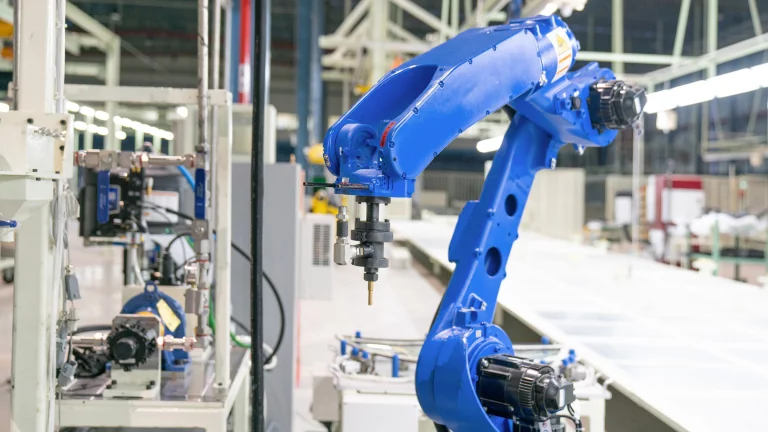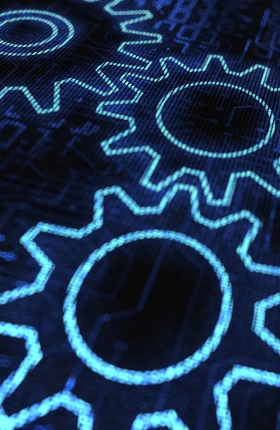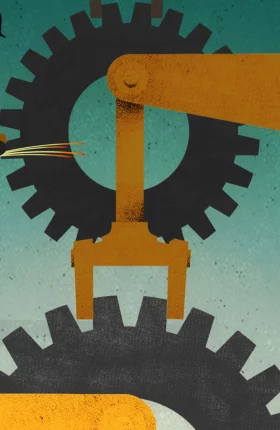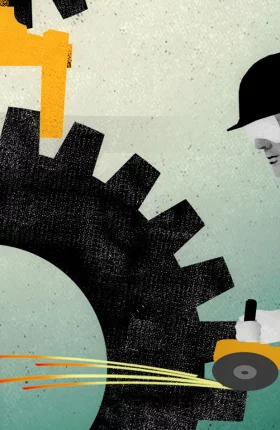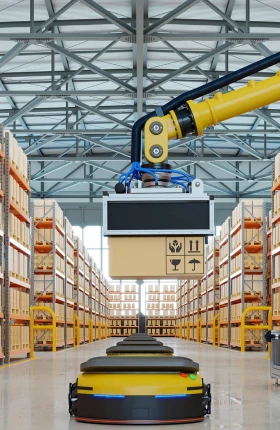Advanced robotics systems are ready to transform industrial operations. Compared with conventional robots, advanced robots have superior perception, integrability, adaptability, and mobility. These improvements permit faster setup, commissioning, and reconfiguration, as well as more efficient and stable operations. The cost of this sophisticated equipment will decline as prices for sensors and computing power decrease, and as software increasingly replaces hardware as the primary driver of functionality. Taken together, these improvements mean that advanced robots will be able to perform many tasks more economically than the previous generation of automated systems.
Producers are now deploying advanced robotics as an essential element of advanced automation that enables the self-controlled factory of the future. Enhancing plant structures and processes with digital technologies can increase productivity and flexibility in both the factory and the supply chain, enabling producers to rapidly adjust to changing customer needs. (See The Factory of the Future, BCG Focus, December 2016.) A BCG analysis found that using advanced robots can reduce conversion costs by up to 15%, and combining advanced robotics with other technologies, process enhancements, and structural layout changes can yield savings of up to 40%.
Combining advanced robotics with other technologies, process enhancements, and structural layout changes can yield savings of up to 40%.
To better understand the opportunities and challenges, BCG recently examined expectations for and adoption of advanced robots in industrial operations. The study focused on the results of a global survey of more than 1,300 executives and operations managers from numerous industries. (See “About the Study.”)
ABOUT THE STUDY
ABOUT THE STUDY
In January and February 2019, BCG conducted a survey of companies to assess their progress toward implementing advanced robotics in industrial operations, which we defined as producers’ core transformation processes, including production and related functions such as maintenance, product quality, and in-plant logistics.
The survey’s participants consisted of executives and operations managers from 1,314 global companies from a broad array of producing industries: automotive, consumer goods, energy, engineered products, health care (pharmaceuticals and medical technology), process industries, transportation and logistics, and technology (media and IT equipment). The participants were based in Austria, Canada, China, France, Germany, India, Italy, Japan, Mexico, Poland, the UK, and the US.
The survey sought to evaluate the participants’ views of the relevance of advanced robotics in operations today (early 2019) and in 2025, to assess the current state of adoption in operations, to understand companies’ future plans, and to identify major challenges and enablers. The survey also asked about the benefits that participants expect to gain from advanced robotics.
Most producers recognize that advanced robotic systems will play an important role in the factory of the future, and they are optimistic about the potential to increase the use of these systems. They maintain this positive outlook despite dissatisfaction with their current progress toward implementation and the performance of these systems to date. Impediments to the broader application of advanced robots include the limitations of the current technology and the high costs of acquiring and operating it. In addition, many producers lack the key enablers of deployment: a target picture of the future factory, organizational competencies, and an appropriate system architecture.
As adoption of advanced robotics increases in the coming years, producers expect several types of functionality—including multispeed usage, mobile applications, and robotic kitting—to become significantly more important. Approximately 70% of survey respondents describe these functionalities as very relevant to their future production. Today, transportation and logistics, technology, and automotive companies lead in unlocking the potential of advanced robots, while engineered products, process, and health care industries lag behind.
Because the factory of the future must address each producer’s distinctive challenges, the precise form it takes will depend on the producer’s region and industry and its company-specific needs. Our survey results confirm that contextual factors are highly relevant to the role of advanced robotics in the factory of the future. Consequently, each company must assess how the deployment of advanced robots can further its particular goals and must identify which enablers it should focus on to capture opportunities.
The Transformative Power of Advanced Robotics
Software and hardware innovations enable the superior features of advanced robotics. Examples include the ability to process large data sets in the cloud, enhanced human-machine interfaces, and sensor technologies. (See “Basics of Advanced Robotics.”)
BASICS OF ADVANCED ROBOTICS
BASICS OF ADVANCED ROBOTICS
Advanced robotics is a key element in the movement toward advanced automation, which is helping to dramatically improve factory operations. What makes automation “advanced”? The defining characteristic is decentralized intelligence that allows devices and equipment to make decisions and take actions autonomously, without human intervention. This autonomy provides the underpinning for self-controlled operations in the factory of the future. Advanced automation consists of four building blocks:
- Holistic Data Models. A holistic data model (also known as a digital twin) consists of a digital representation of products and the production system along their life cycles. It permits virtual commissioning of production systems, including equipment setup and integration, through simulation technologies. Production equipment (such as advanced robots) can access the models to, for instance, plan the required path on the fly.
- Cloud-Edge Infrastructure. Cloud-edge infrastructure shifts computational power and storage to the production network’s edges, thereby bridging the domains of IT and operations technology. Such infrastructure is more effective than traditional IT infrastructure at helping producers overcome such challenges as data latency, limited bandwidth, and intermittent connectivity on the shop floor. It allows producers to collect data and transfer it to cloud services for processing. In addition, it enables processes on the shop floor to adjust autonomously to environmental changes.
- Data-Processing Technologies. If it is to be converted into meaningful information, data of different sizes, velocities, and shapes—ranging from transactional objects (such as images) to Internet of Things data—requires timely processing. Recent advances in data processing technologies allow producers to continuously optimize processes (such as path planning).
- Workflow Control System. A workflow control system synchronizes all tasks that equipment or human workers perform in manufacturing and logistics processes. It is the backbone of machine-dominated system configurations. Efficient management of the entire workflow requires the digital connection or integration of both machines and human workers. Workflow control system configurations are likely to evolve from centralized architectures into decentralized ones.
These building blocks, combined with equipment-specific innovations, help unleash the potential of advanced robotic systems. The enhancements that they offer over conventional robotic systems involve four types of functionality:
- Perception. Major improvements in natural-language processing, computer vision, and sensors (such as those that can detect force or torque) support increased autonomy, dexterity, and precision. This improved functionality, in turn, allows robots to perform more-complicated tasks and finish work without interruption.
- Integrability. New service-oriented architectures, better connectivity, access to holistic data models, and interface and programming improvements (such as plug-and-play functionality) accelerate the setup process and minimize the effort required to teach robots to perform tasks.
- Adaptability. Advances in data- processing technologies and access to cloud services enable robots to learn and autonomously adapt to complex, changing environments. Improved workflow control systems allow robots to react quickly to changes in order processing.
- Mobility. With machine learning and computer vision, advanced robots can autonomously guide themselves through complex environments. Self-driving robots and aerial drones are examples. Anticipated future improvements in portability will facilitate the use of robots at multiple locations, even in robotic systems that are not equipped with wheels.
Various types of robotics systems with these traits are relevant to industrial operations. The most important examples today are industrial robots (such as articulated robots and selective compliance assembly robot arms), collaborative robots, and automated guided vehicles used in logistics operations. In the long term, we expect distinctions among advanced robots to be less well defined, as some will be able to perform tasks in both manufacturing and logistics.
The potential to transform factory processes has sparked tremendous excitement among producers about advanced robots and advanced automation in general. As a result, the market for advanced robotics is growing rapidly. (See Exhibit 1.)
Producers see advanced robotics as a way to address the increasing complexity of their manufacturing operations. In recent years, the number of product variations, the frequency of new product launches, and demand for customized products have increased dramatically. In this more complex operating environment, the ability of conventional automation to meet producers’ requirements for transparency, productivity, and flexibility has reached its limit. At the same time, labor shortages and higher labor costs have increased the pressure on producers to automate tasks that human workers currently perform manually.
Advanced robotics can yield various benefits:
- Productivity. Automation of manual tasks drives higher productivity as advanced robots take over such previously manual tasks as assembly of flexible parts. The ability of advanced robots to self-adjust to changing process parameters improves resilience by eliminating “microstops” that often occur in conventional robotics processes. In addition, advanced robots are significantly easier than conventional robots to set up and reconfigure, if suitable simulation software is available, and they are quicker at learning how to perform tasks. The rapid ramp-up of processes is especially valuable for production systems that require frequent adjustments, such as in response to product changeovers or customization requests.
- Quality. Advanced robots can outperform human workers on some tasks, such as assembly, delivering greater reliability and precision, and thus improving quality.
- Safety. Compared with conventional robots, advanced robots can perform more tasks that are dangerous or physically demanding for human workers—such as tasks performed in hazardous environments or operations that could lead to repetitive-stress injuries. The use of machine-vision technologies that improve robots’ perception can enhance safety, even in fenceless environments.
- Agility. Producers can use advanced robotics in configuring new production systems that meet the rising demand for more product variations, customized products, and product redesigns. (See Will Flexible-Cell Manufacturing Revolutionize Carmaking? BCG Focus, October 2018.)
Study participants recognize the potential: 52% of them expect advanced robotics to become one of the most important drivers of productivity improvement by 2025. Expectations vary significantly among regions, however. Companies in Europe and Asia are more likely than those in North America to see advanced robotics as an important productivity driver today. Nevertheless, North American companies have high expectations for the future. The number of US companies that expect advanced robotics to be the most important productivity driver by 2025 is 12 percentage points higher than the number that see it as the most important driver today.
Survey respondents expect multispeed usage, mobile applications, and robotic kitting to become significantly more important. At the same time, however, the importance of collaborative robots in supporting manual tasks, as they are used in many pilot applications today, will decrease relative to other applications. In many cases, to achieve positive economics for investment, robots must replace human workers, rather than merely support them.
Advanced robotics will have a major effect on the workforce. Jobs that primarily involve routine manual activities (such as loading and unloading machines) are the likeliest to be fully automated. For jobs that involve both routine and nonroutine tasks, the share of nonroutine tasks (such as maintenance and shop-floor management) will increase. As manual work shifts toward nonroutine tasks, workers must acquire more-advanced skills. New job categories will arise as technological adoption introduces new needs. Human roles will shift toward tasks that require technical capabilities and soft skills (such as the ability to take initiative). For example, technicians will deal primarily with errors that automated systems cannot handle.
Most survey participants expect the use of advanced robots to reduce the total number of employees at their company, although regional differences are evident in the results. (See Exhibit 2.) Among participants from Asian companies, 56% expect the number of employees to decline by at least 5% within the next five years. This expectation was strongest among participants from Chinese companies: 67% of them expect the number of employees to decline by at least 5%, and 21% expect the reduction to exceed 20%. Fewer participants from North America (50%) and Europe (44%) expect a decline of at least 5%. Participants from most countries expect demand for white-collar workers to increase.
Overall, companies plan to accelerate the creation of industrial engineering jobs dedicated to robotics—for example, jobs dedicated to developing and customizing robotics solutions. Among survey participants, 62% say that their company plans to increase the number of such employees. Companies in China are the most ambitious in this regard, while companies in Japan are comparatively cautious. The enthusiasm of Chinese companies reflects the fact that automation and robotics are key priorities in the government’s “Made in China 2025” strategic plan.
Industrial Applications of Advanced Robotics
Capabilities derived from advanced robotics enable new applications across factory operations. More than 40% of survey participants rate advanced robotics as a very important productivity driver today in production and logistics, and approximately 70% expect advanced robotics to become a very important productivity driver in production and logistics by 2025. Participants also expect to see significant productivity gains in quality and maintenance.
Approximately 70% of survey participants expect advanced robotics to become a very important productivity driver in production and logistics by 2025.
Although individual companies will find different applications valuable, the following examples along the value chain illustrate potential opportunities.
Production. Advanced robots are already present in production environments, and their importance will grow over the next few years. Discrete production, rather than continuous production, is likely to see the most valuable applications of advanced robotics. For example, a particular producer of sealing solutions uses more than 40 robots to load and unload machines in its manufacturing cells.
Producers, especially in the automotive industry, also use advanced robots to autonomously process work pieces or to perform assembly processes. For instance, an automotive OEM uses robots to mount protective foils under high pressure on the inside of car doors. Since advanced robots can self-adjust on the basis of environmental perception, they can perform complex assembly processes, such as those involving flexible parts. Direct, real-time communication between work pieces and robots—for example, by using radio-frequency identification technology—also supports assembly. For example, robots can quickly change tools as needed, without requiring explicit prior instruction. To facilitate introducing robots into processes, companies rely on simplified interfaces between robots and other equipment and on the ability to use existing information, such as digital product-data models, to deduce relevant process parameters. (See “Integrating Technologies to Create Autonomous Production Processes.”)
INTEGRATING TECHNOLOGIES TO CREATE AUTONOMOUS PRODUCTION PROCESSES
INTEGRATING TECHNOLOGIES TO CREATE AUTONOMOUS PRODUCTION PROCESSES
New design technologies, additive manufacturing, and cloud-edge technologies open up new opportunities to create autonomous, decentralized production processes. BCG is exploring the opportunities in a joint initiative with Amazon Web Services, NXP Semiconductors, and the Laboratory for Machine Tools and Production Engineering of RWTH Aachen University.
Here is how the application works: A holistic data model (or digital twin) of products and production equipment (such as robots or gripping devices) is stored in a cloud system. Process planning and simulations related to the use of equipment are conducted via cloud services, independently of the hardware. The architecture permits continuous process optimization and end-to-end process monitoring. Encrypted communication secures data transfer, among other benefits.
Additive-manufacturing technologies are used to produce parts, which an advanced robot then picks up and moves. Because the robot’s path of movement is based solely on the relevant data models of products, processes, and equipment, there is no need for manual intervention.
In the near term, improvements will enable some types of advanced robots to autonomously perform processes at the same high speed as conventional industrial robots. In addition, the safety features of advanced robots—including the ability to work at slower speeds than conventional robots, as needed—mean that they can share workspace with humans without the need for protective fences.
Augmented with the technology used in automated guided vehicles (AGVs), advanced robots will be able to complete tasks involving movement across large workspaces, such as mounting parts at various locations or processing large work pieces. Applications being tested in pilot deployments include the use of autonomous mobile robots to perform ergonomically challenging automotive assembly processes. Several years of additional research and testing by robot manufacturers and producers will be necessary, however, before mobile applications can be fully deployed.
To be economically viable in the production environment, advanced robots must take over manual processes, not merely assist human workers with those processes. Many companies have struggled to demonstrate the economic viability of investing in robots that collaborate with human workers. Applications in which workers and robots perform tasks side by side, without interaction, tend to be easier to realize.
Logistics. Our study focused on in-plant logistics and warehousing. Autonomous mobile robots are gaining importance in in-plant logistics and will eventually replace both fixed conveyor belts and conventional AGVs that rely on magnetic strips for guidance. Survey participants expect that autonomous logistics robots will be more important than conventional AGVs by 2025. Several types of autonomous mobile robots can undertake both transportation and loading tasks. For instance, robotics producers are testing early applications of mobile robots that autonomously supply workstations. In addition to using robots for ground transport, companies may find that air transport via drones is feasible. Approximately 50% of survey respondents say that air transport could be relevant to their operations by 2025.
Autonomous robots can perform picking, packaging, and palletizing operations. Using robots for kitting tasks is another promising application, but some challenges in this area remain to be overcome. Sensors and machine learning are essential so that robots can identify, pick, and handle unsorted or flexible parts in bins. The first industrial applications of this type have recently become available.
Quality. Advanced robots can control inline quality by automatically adjusting equipment parameters in response to perceived quality. Small robots can recognize damage and perform automated inspections of large parts, and mobile robots can autonomously move testing equipment to the places where it is currently needed.
Maintenance. Mobile robots can support maintenance by transporting spare parts and performing mobile inspections. For example, a robotics producer has developed advanced robots that perform remote visual inspection of tanks, vessels, and pipes. Such applications are most relevant to process industries, where inspections are often difficult to perform.
Among study participants, expectations that various industrial applications will become very important by 2025 ranged from 53% to 67%. (See Exhibit 3 for an overview of the applications that survey participants rank as most relevant for the factory of the future.)
Comparing Ambition and Reality
Our study found that companies have high ambitions for deploying advanced robots as part of a broader transition to advanced automation. Companies plan to increase their level of automation, on average, by more than 15 percentage points from early 2019 through 2025, driven significantly by advanced robots. Although 86% of companies plan to deploy advanced robots in their operations within the next three to five years, only 20% have created a holistic target picture and a comprehensive implementation roadmap.
Across industries, more than 80% of participants say that their company has already gained experience in deploying advanced robots. However, only 11% of participants say that their company has successfully implemented such systems in multiple areas of their production facilities. Participants cited robotics systems’ low levels of maturity and performance as the main reasons for the low success rate. Only 30% of participants say that robotics technology has developed to the point of fully meeting their needs. For instance, only 15% of Japanese participants say that the technology meets their expectations for maturity. Perceptions of maturity are also relatively low among participants in the US (24%) and Germany (26%).
Companies in the transportation and logistics, technology, and automotive industries currently lead in implementing advanced robotics. Companies in the engineered products, process, and health care industries lag behind. (See Exhibit 4.)
European and Asian companies currently lead in implementing advanced robots, while implementation in North America has proceeded more slowly. In each of the 12 countries in our study, most of the companies we surveyed plan to implement advanced robotics within the next three years. (See Exhibit 5.) Companies in emerging nations, especially China and India, tend to be even more enthusiastic than those in industrialized nations about using advanced robots, even though the savings achieved by replacing manual activities would not be as high. These companies may be looking to automation as a way to compensate for a shortage of skilled labor and to improve quality, thereby enhancing their ability to compete in international markets. Also, in general, significant government funding and less concern about job losses help to fuel excitement about technology.
The size of the company affects robotics adoption. Small businesses are less likely than large businesses to use advanced robotics applications. Among companies with revenues exceeding $1 billion, 90% have already implemented advanced robotics applications, but the share of implementers among companies with revenues of less than $250 million is significantly lower. Small businesses’ lower level of adoption probably reflects budgetary constraints with respect to testing applications and gaining access to robotics-related expertise.
Survey participants generally do not expect the costs of robotics to decline—the only exception being participants from Chinese companies. Nevertheless, we expect the required outlays for advanced robots to decrease. Robot producers are likely to find that the cost of manufacturing their equipment declines, owing to scale effects arising from higher demand and productivity improvements in development and production. Users’ upfront investments may also be reduced by subscription and by “robotics as a service” models that replace traditional purchasing or leasing models.
Unlocking the Potential
The study’s findings point to the need for effective action by both industrial companies and producers of advanced robots. (See “Implications for Robot Producers.”) To successfully deploy advanced robots and to quickly benefit from new technologies as they become available, industrial companies must establish three types of enablers: they must define the target picture of the future factory, build organizational competencies, and design the system architecture. Overall, 92% of participants in the study think that one or more of the key enablers are not fully in place at their companies.
Overall, 92% of participants in the study think that one or more of the key enablers for advanced robotics are not fully in place at their companies.
IMPLICATIONS FOR ROBOT PRODUCERS
IMPLICATIONS FOR ROBOT PRODUCERS
Advanced robotics systems offer great opportunities for established producers of robots, producers of other advanced automation solutions, and new entrants in the field. But robot producers must also deal with significant challenges, including the need for high R&D investments and the need to forecast sales accurately in an increasingly complex environment. Indeed, some prominent producers of advanced robots have gone out of business as a result of disappointing sales.
Because some promised breakthroughs have failed to materialize, many executives of companies that purchase robotics solutions are skeptical when robotics producers or market experts describe significant technological advances. Survey participants say that they require not only mature and robust technologies, but also lower investment costs.
To meet users’ expectations, robot producers must focus on improving both software and hardware:
- Software will be the primary differentiator for advanced robotics systems. Producers can use software as the basis for new business models, including the monetization of pushed upgrades, subscription-based pricing, and performance-based contracts. However, they must ensure that their solutions can be integrated in their customers’ system architecture.
- To reduce the need for complicated programming on the shop floor, it is essential to improve user interfaces. Conventional industrial robots’ interfaces fall short of meeting usability requirements. Advances in augmented reality, natural-language processing, haptic feedback, and computer vision offer intriguing opportunities to improve interfaces.
- Producers must further leverage or adapt sensors for industrial applications. Scale effects resulting from higher demand in the automotive and consumer industries will help to reduce costs in this area.
- Although mechanical systems of industrial robots are already quite mature, improvements are needed in modularity, flexibility, dexterity, and mobility. Robot producers can leverage materials that possess enhanced characteristics to improve the capabilities of robots and broaden the areas of application.
Define the target picture of the future factory. Decision making about advanced robotics extends beyond capital investments to encompass strategic choices that affect many aspects of an industrial company’s business model, such as the product mix and the manufacturing footprint. To address the full scope of decisions, a company must develop a holistic target picture of the factory of the future. This vision should encompass the implementation of multiple automation technologies, including advanced robotics.
The target picture should define the future operations setup—including, for example, quantities, lot sizes, product variations, and plant layout and processes. It should also take into account the business context (such as market trends and the development of labor costs). To detail the target picture, a cross-functional team must collaborate in defining areas of operations in which advanced robotics could add value, and it must determine the implications of these operations on the design of the factory and processes, including logistics, maintenance, and quality management. For example, companies must rethink processes related to the supply of parts to workstations. They must also assess the availability of—and economics of investing in—mature technologies. Process simulations are a useful way to evaluate various options.
To achieve the target vision, the company must define key transition steps. This provides the basis for a detailed implementation roadmap, including measurable targets for investments. First movers can capture a significant advantage, but the risk of a failed implementation is high if the technology is not mature. To mitigate the risk, the company should test solutions rapidly in specific areas of the factory. A company should also consider opportunities for collaborating on pilot programs with manufacturers of robotics or other producers. The company should rapidly scale up solutions that have performed well at the pilot stage, in the relevant areas of operations.
Build organizational competencies. The company’s leadership must clearly communicate to the entire organization about how advanced robots will transform operations, and it must redefine roles and responsibilities as needed. The company must build knowledge throughout the organization about the opportunities, limitations, and risks involved in implementing various robotics solutions. Managing advanced robotics systems requires employees to exercise both functional and soft skills. Many employees will need to receive training in robotics installation, programming, operations, and maintenance. Whether through training, new hires, or the use of external experts, companies must gain essential knowledge on how to best integrate advanced robots into operations. This includes thinking creatively about how robots can perform diverse tasks. Employees also need capabilities to tailor standard solutions to specific tasks. Although survey participants rank implementation knowledge as one of the three most important enablers, only 36% think that their current knowledge is sufficient.
Design the system architecture. To take full advantage of advanced robotics, the company must review the system architecture that supports its operations processes. It must establish a wide array of capabilities, including those related to edge computing, analytics, data and workflow management, cybersecurity, industrial software, automation equipment, and infrastructure. By developing a comprehensive view of the system architecture, the company can choose strategic suppliers that can integrate their products into the defined system.
It is essential that the company create a holistic data model of products and equipment (including control technology). Among other benefits, this digital twin integrates real-time and historical information about the production system. A holistic data model enables machine learning, permitting analysis of various scenarios to optimize the operation and maintenance of advanced robots. For example, as noted, robotics systems use digital twins and sensor information to deduce changes in process parameters and to rapidly reconfigure themselves in response. Often, companies today do not make sufficient use of information about the production system, especially information stored in product-life-cycle management systems.
To safeguard data flowing through robotics systems, the company must secure the IT infrastructure against cyberattacks. Decentralized systems and processes increase the number of potential gateways for cyberattacks—and the magnitude of the potential harm. Among survey participants, 87% say that cybersecurity has gained importance in their operations.
Our study demonstrates that nearly all industrial producers recognize the importance of advanced robotics and plan to further implement this technology in their factories. But the vital connection to an overall vision of the factory of the future is absent in many cases. To fully capture the benefits of advanced robotics, producers must quickly develop a target picture for the factory of the future and identify the most promising applications of advanced robotics within the context of holistic optimization. They must also ensure that their organization and system architecture are ready to tackle the challenges of implementation. The time for taking a wait-and-see approach has passed. To win in the 2020s, all producers must implement advanced robotics as part of a comprehensive digital transformation of their operations.
